英语教案范文全英文版初中
初中英语教案设计模板全英文版(共8篇)
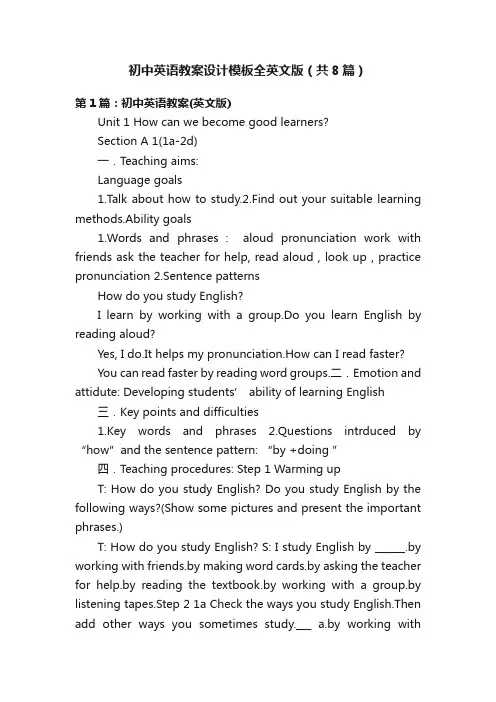
初中英语教案设计模板全英文版(共8篇)第1篇:初中英语教案(英文版)Unit 1 How can we become good learners?Section A 1(1a-2d)一.Teaching aims:Language goals1.Talk about how to study.2.Find out your suitable learning methods.Ability goals1.Words and phrases:aloud pronunciation work with friends ask the teacher for help, read aloud , look up , practice pronunciation2.Sentence patternsHow do you study English?I learn by working with a group.Do you learn English by reading aloud?Yes, I do.It helps my pronunciation.How can I read faster?You can read faster by reading word groups.二.Emotion and attidute: Developing students’ ability of learning English 三.Key points and difficulties1.Key words and phrases2.Questions intrduced by “how”and the sentence pattern: “by +doing ”四.Teaching procedures: Step 1 Warming upT: How do you study English? Do you study English by the following ways?(Show some pictures and present the important phrases.)T: How do you study English? S: I study English by ______.by working with friends.by making word cards.by asking the teacher for help.by reading the textbook.by working with a group.by listening tapes.Step 2 1a Check the ways you study English.Then add other ways you sometimes study.___ a.by working withfriends.___ b.by making word card.___ c.by reading the textbook.___ d.by listening to tapes ___ e.by asking the teacher for help.…Step 3 Listening1)Listen.How do these students study for a test? Write letters from 1a above.2)Check the answers: b(Meiping);e(Peter);d(Tony)Step 4 Gue Show some pictures.Gue: How does he/she study English? He/She studies English by…How do they study English? They study English by… Step 5 Pairwork1c Make conversations about how you study for a test.A: How do you study for a test?B: I study by working with a group.A: How do you study for a test?B: I study by… Step 6 Listening2a Listen and check the questions you hear.1 ____ Does anyone learn English by watching videos? 2 ____ Do you have conversations with friends in English? 3 ____ What about listening to tapes? 4 ____ What about reading aloud to practice pronunciation? 5 ____ Have you ever studied with a group?Answers: 1, 2, 4, 5 2b Listen again.Match each answer below with a question above.a.Yes, I have.I’ve learned a lot that way.b.Oh, yes.It really improves my speaking skills.c.I do that sometimes.I think it helps.d.No.It’s too hard to understand spoken English.Answers: d, b, c, a Step 7 Pairwork 1.2c Make conversations using the information in 2a and 2bA: Have you ever studied with a group?B: Yes, I have.I’ve learned a lot that way.Show some pictures.1)A: Do you learn English by watching movies?B: Yes, it’s a very interesting way.C: No, it’s too hard tounderstand spoken English.2)A: What about writing letters to a pen pal in America?B: Yes, it helps to improve my writing skills and know a lot aboutAmerica.3)A: Do you have conversations with friends in English?B: Of course, we can talk about plenty of things like school, pets,movies, and our parents.Step 8 SummaryHow do you study English?1.by working with friends2.by watching English movies.3.by making word cards.4.by reading the textbook.5.by listening to tapes.6.by asking the teacher for help.7.by reading aloud.Step9 Homework How do you study English? What about physics and Chinese? Make a list.第2篇:初中英语说课稿获奖全英文版Oral Presentation of Leon Plan for Unit 12 My favorite subject is science Go for it Grade 7(注:本说课稿根据“2007年首届全国中学英语教师教学基本功大赛暨教学观摩研讨会(初中)”)[Presenting the 1st PPT about the introduction.] Well, good afternoon ladies and gentlemen, I am very happy to meet you all here.Today,I am going to present Unit 12 Writing.Well, please look at the teaching material together.Well, this is a letter in the book.Students are required to read it through, have a look at it, try to write a letter to Zhao Jie, a boy who doesn’t like any subjects at all.[Presenting the 2nd PPT about the given letter.] Well, I think my teaching aims should include the proper form of English letter, and second, how to write a letter in an idiomatic way.[Presenting the 3rd PPT about the teaching aims.]Well, to achieve these goals, I am going to arrange myteaching step by step [Presenting the 4th PPT about the teaching procedures].Well, these are the steps, since so many, let me make it simple, actually, they are words, sentences and paragraphs.As we know that articles consist of words and sentences.So first, I would like to talk about the words.That is also the first step---revision.Well, you know, students have learned the names of the subjects in the former leons.So, I am going to review the words by playing games with them.Here comes the first game: who can write more? [Presenting the 5th PPT about the 1st game]I am going to divide the students into two groups, for example boys and girls.They are given two minutes to rush to the blackboard and write down the subjects they know.The group which can write more will be the winner.Imagine how excited the students are, and at the same time, they are also reviewing the words.Well, what’s more, you may have noticed these two subjects, Physics and Chemistry.[Presenting the 6th PPT about the result of the game] Actually, these two subjects are not in this book.So, in this way, we can know that some students are showing us how much they know and all the students can also enlarge their vocabulary at the same time.Well, after words, I would like to turn to sentences.Here comes the second game, who can make it longer? [Presenting the 7th PPT about the 2nd game] I am going to give students a word, for example subject.Which students can make it longer? Well, you please.Favorite subject.Good.A phrase appears.Longer? You please.My favorite subject is English.Well, a sentence appears.Even longer? My favorite subject is English, I like it very much, it is so interesting.[Presenting the 8th PPT about the answers of the game]Well, you can see students are constructing words into sentences step by step.Well, this is the revision part.After that, it is time to read.From now, I am going toshow students the given material so soon.Actually, instead, I am going to show them those separated pieces.They should put them into the correct order[Presenting the 9th PPT about the reordering task].You know before the leon, I divided the whole letter into these four parts, why do I bother to do this? Well, you can see, in this way, students can put more attention to how to begin and how to end a letter.Then, they have a time, can have a chance to read through the whole article[Presenting the 10 th PPT about the reading material].Well, at the same time, they should also pick out those well used words and sentences, and share them with the whole cla.Then, they have a discuion “what information can we use? [Presenting the 11th PPT about the discuion task]Why talking about subjects? Of course, it is easy for them to find these information like these three ones(time & day, teacher, reason), because they are in the letter.But what else? Students need to think about that.Well, why? As we know it is easy to copy, but difficult to create.Sometimes, the given material gives us a good example, but sometimes, they may also limit students’ ideas.So they need to go further.As some teachers may prefer to offer the answers directly to the students.But I am not.I think teaching students how to learn is much more important than just teaching knowledge.So students should think about that by themselves.Well, this part is also a brainstorm to them.Till now, they have known so much.Since that, they should be given a chance to put wha t they’ve known into practice.So I prepare two practices[Presenting the 12th PPT about the 2 practices].Practice number one, students have a Free Talk about their favorite subjects, if they can expre themselves fluently and naturally, they won’t have much difficulty in writing them down.Well, second practice will be the real writing.They aregiven eight minutes to write a letter to Zhao Jie[Presenting the 13th PPT about the beginning of the letter].Well, when they finish writing, six students get into a group, they exchange their letters and try to correct mistakes.Why they should do that? Well, teachers may have noticed that not many students have the habit of rewriting and correcting mistakes when they finish writing, and I want them to realize this is also very important.Ok, after that, each group chooses two representatives, the best one and the one who has made great progre.Which two? I think not only those advanced students but also the le advanced students should be given a chance to show how good they are.Well, for example, yes, after that, some representative come to the front and show their letters to the whole cla, but you can think it is a projector like this.This is a student’s letter and when all students finish writing it, they are welcomed to give comments.It is so-so, good or great.So which one? Can you find any beautifull sentences here? They are welcomed to give their ideas.Well, here comes the last part[Presenting the 14th PPT about the homework].Last part will be the homework.They can either write me an email or have a talk with some one or write an article about his or her favorite ********.I think both of these are highly connected with our daily life.So, students must be very interested.Ok, so that is all.Thank you very much!(答辩问答)Questions:Anyhow, I appreciate your teaching, and allow me to say so.My question is “ how do you check the achievements of the homework you send to your pupils?Answer:Well, about this question, I think, first, still the group work.They should exchange their letters and each group should also choose two representatives and hand in the letters or the articles they have written to me, and I correct them bymyself.And then, put all these representatives’ works on the wall and show them to the whole cla.By this way.Thank you!第3篇:全英初中英语教案鲁人办发[2008]78号关于做好2008年省内高校特困家庭毕业生求职补贴发放工作的通知各高等学校:按照山东省人民政府办公厅《关于做好特困家庭高校毕业生就业工作的通知》(鲁政办发[2008]21号)要求,现就做好2008年省内高校特困家庭毕业生求职补贴发放工作有关事项通知如下:一、发放范围求职补贴发放范围为符合城乡低保、零就业家庭、农村贫困家庭等特殊情况,就业有困难需要帮助的2008年省内高校山东生源应届毕业生(以下简称特困生)。
初中英语课堂教学设计案例优秀9篇
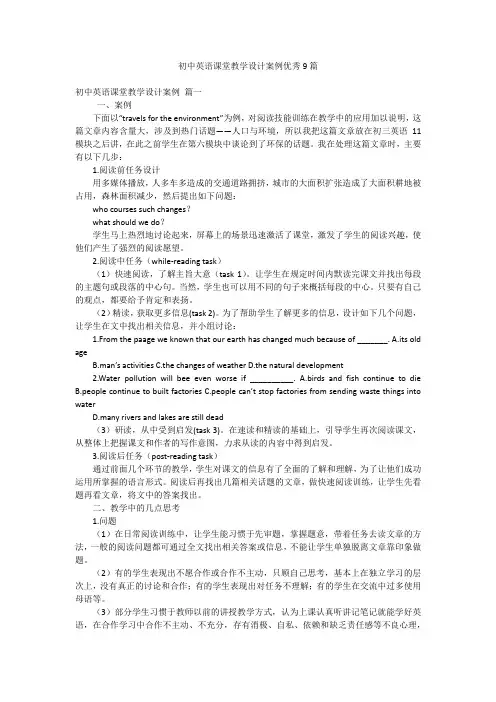
初中英语课堂教学设计案例优秀9篇初中英语课堂教学设计案例篇一一、案例下面以“travels for the environment”为例,对阅读技能训练在教学中的应用加以说明,这篇文章内容含量大,涉及到热门话题——人口与环境,所以我把这篇文章放在初三英语11模块之后讲,在此之前学生在第六模块中谈论到了环保的话题。
我在处理这篇文章时,主要有以下几步:1.阅读前任务设计用多媒体播放,人多车多造成的交通道路拥挤,城市的大面积扩张造成了大面积耕地被占用,森林面积减少,然后提出如下问题:who courses such changes?what should we do?学生马上热烈地讨论起来,屏幕上的场景迅速激活了课堂,激发了学生的阅读兴趣,使他们产生了强烈的阅读愿望。
2.阅读中任务(while-reading task)(1)快速阅读,了解主旨大意(task 1)。
让学生在规定时间内默读完课文并找出每段的主题句或段落的中心句。
当然,学生也可以用不同的句子来概括每段的中心。
只要有自己的观点,都要给予肯定和表扬。
(2)精读,获取更多信息(task 2)。
为了帮助学生了解更多的信息,设计如下几个问题,让学生在文中找出相关信息,并小组讨论:1.From the paage we known that our earth has changed much because of _______. A.its old ageB.man’s activitiesC.the changes of weatherD.the natural development2.Water pollution will bee even worse if __________. A.birds and fish continue to dieB.people continue to built factoriesC.people can’t stop factories from sending waste things into waterD.many rivers and lakes are still dead(3)研读,从中受到启发(task 3)。
初中英语教案(英文版)
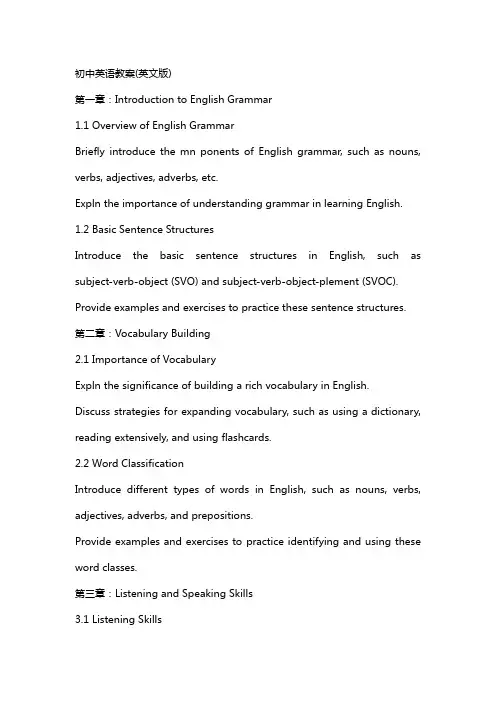
初中英语教案(英文版)第一章:Introduction to English Grammar1.1 Overview of English GrammarBriefly introduce the mn ponents of English grammar, such as nouns, verbs, adjectives, adverbs, etc.Expln the importance of understanding grammar in learning English. 1.2 Basic Sentence StructuresIntroduce the basic sentence structures in English, such as subject-verb-object (SVO) and subject-verb-object-plement (SVOC). Provide examples and exercises to practice these sentence structures. 第二章:Vocabulary Building2.1 Importance of VocabularyExpln the significance of building a rich vocabulary in English. Discuss strategies for expanding vocabulary, such as using a dictionary, reading extensively, and using flashcards.2.2 Word ClassificationIntroduce different types of words in English, such as nouns, verbs, adjectives, adverbs, and prepositions.Provide examples and exercises to practice identifying and using these word classes.第三章:Listening and Speaking Skills3.1 Listening SkillsDiscuss the importance of listening skills in learning English. Introduce strategies for improving listening prehension, such as active listening, note-taking, and predicting.Provide listening exercises with acpanying tasks to practice these skills.3.2 Speaking SkillsExpln the significance of speaking skills in munication.Introduce techniques for effective speaking, such as proper pronunciation, clear articulation, and appropriate intonation.Provide speaking exercises, including role-plays and discussions, to practice these skills.第四章:Reading Comprehension4.1 Importance of Reading ComprehensionDiscuss the importance of reading prehension in learning English. Expln how reading prehension skills can enhance understanding and enjoyment of English texts.4.2 Strategies for Reading ComprehensionIntroduce various strategies for improving reading prehension, such as skimming, scanning, and close reading.Provide reading passages with acpanying questions to practice these strategies.第五章:Writing Skills5.1 Basics of WritingIntroduce the basic elements of writing, such as topic, introduction, body paragraphs, and conclusion.Discuss the importance of proper formatting and citation in academic writing.5.2 Writing TechniquesExpln different writing techniques, such as narrative, descriptive, and persuasive writing.Provide writing prompts and exercises to practice these techniques, including peer review and editing.这五个章节涵盖了初中英语教学的主要内容,包括语法、词汇、听说技能、阅读理解和写作技巧。
初中优秀英语教案范文5篇
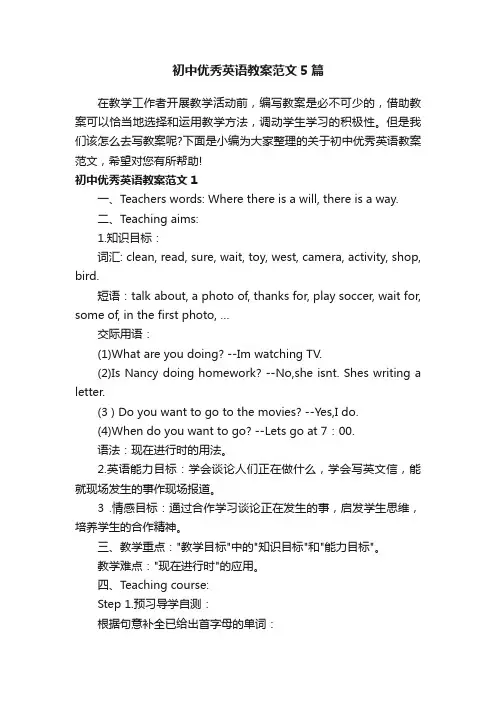
初中优秀英语教案范文5篇在教学工作者开展教学活动前,编写教案是必不可少的,借助教案可以恰当地选择和运用教学方法,调动学生学习的积极性。
但是我们该怎么去写教案呢?下面是小编为大家整理的关于初中优秀英语教案范文,希望对您有所帮助!初中优秀英语教案范文1一、Teachers words: Where there is a will, there is a way.二、Teaching aims:1.知识目标:词汇: clean, read, sure, wait, toy, west, camera, activity, shop, bird.短语:talk about, a photo of, thanks for, play soccer, wait for, some of, in the first photo, …交际用语:(1)What are you doing? --Im watching TV.(2)Is Nancy doing homework? --No,she isnt. Shes writing a letter.(3 ) Do you want to go to the movies? --Yes,I do.(4)When do you want to go? --Lets go at 7:00.语法:现在进行时的用法。
2.英语能力目标:学会谈论人们正在做什么,学会写英文信,能就现场发生的事作现场报道。
3 .情感目标:通过合作学习谈论正在发生的事,启发学生思维,培养学生的合作精神。
三、教学重点:"教学目标"中的"知识目标"和"能力目标"。
教学难点:"现在进行时"的应用。
四、Teaching course:Step 1.预习导学自测:根据句意补全已给出首字母的单词:1、My little brother is w_____ a letter.2、The students are c_____ the classroom.3、The boy is taking a photo with a c______.4、Are they w_____ for a bus over there?5、Hes r_____ a newspaper.小小翻译家:1、talk about________2、a photo of________3、wait for________4、in the first photo________5、电话交谈________6、踢足球________7、因…而感谢________ 8、许多图书馆_______Step2情境导入Look at the pictures in P25 1a and write sentencesNow its 6:00 pm. What are they doing?In picture A. She is talking on the phone.In picture B. ________________________In picture C. ________________________In picture D. ________________________In picture E. ________________________In picture F. ________________________Step3自主探究1.以上练习的句子是什么时态?_______________________________.2.该时态的结构是_________________________________________.3.现在分词的构成规则A、一般直接在动词后加______,如reading,watch_____, talk____ .B、以字母不发音的e结尾的____________,如writing,come_______, make ____ .C、一个元音字母加一个辅音字母结尾且末尾只有一个辅音字母的重读闭音节词要_____________________ 。
初中仁爱版英语教案3篇仁爱版初中英语教案英文版
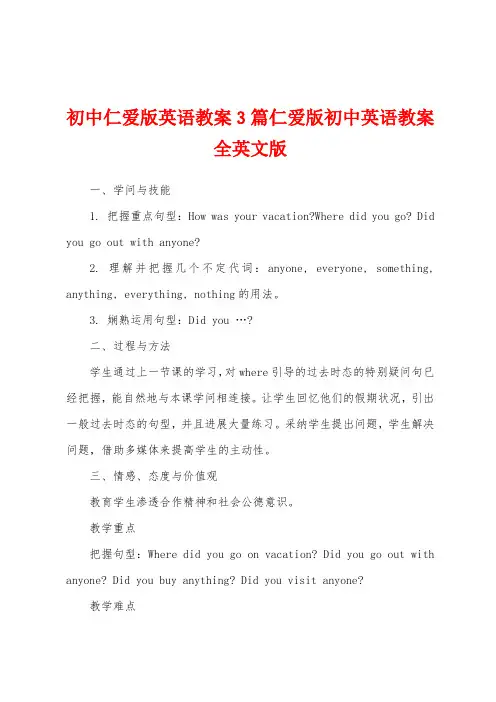
初中仁爱版英语教案3篇仁爱版初中英语教案全英文版一、学问与技能1. 把握重点句型:How was your vacation?Where did you go? Did you go out with anyone?2. 理解并把握几个不定代词:anyone, everyone, something, anything, everything, nothing的用法。
3. 娴熟运用句型:Did you …?二、过程与方法学生通过上一节课的学习,对where引导的过去时态的特别疑问句已经把握,能自然地与本课学问相连接。
让学生回忆他们的假期状况,引出一般过去时态的句型,并且进展大量练习。
采纳学生提出问题,学生解决问题,借助多媒体来提高学生的主动性。
三、情感、态度与价值观教育学生渗透合作精神和社会公德意识。
教学重点把握句型:Where did you go on vacation? Did you go out with anyone? Did you buy anything? Did you visit anyone?教学难点能用句型Did you …?提出尽可能多的有关过去假期的问题。
教法导航创设情境,让学生自己总结规律,思索,争论,最终得出结论。
创设英语语言气氛,使学生能较快地融入到英语语言学习的情景中来。
学法导航自主学习,独立思索,小组争论,同桌合作,完成学习任务。
教学预备视频,图片,多媒体。
教学过程Step 1 GreetingsGreet the class as usual.Step 2 RevisionAsk the students to look at the picture on Page 1 and make conversations, using the sentence pattern: —Where did you go on vacation? —I went to the mountains. —Did you go with anyone? —Yes, I did. / No, I didn’t.Step 3 Role playThe teacher acts as Rick and ask a student to act as Helen and practice the dialogue of 2d on Page 2. Then ask the students to practice in pairs and finally ask two or three pairs to act it out.Step 4 Grammar FocusReview the grammar box. Ask students to say the questions and answers.Review the difference between regular –ed past tense verbs (stay –stayed, visit-visited) and irregular past tense verbs (go –went, buy-bought). Then get the students to ask and answer the questions and answers in pairs.Step 5 GameAsk one student to act as the teacher and ask some individual students questions. Get as many students as possible to be the teacher.Then ask the students to pay attention to the words: no one, anyone, everyone, something, nothing, anything.Step 6 Practice3a Fill in the blanks with the words in the box and practice the conversation.3b Fill in the blanks in the e-mail mestudentsage with the words in the box.After checking the answers, get the students to read them aloud. Step 7 Group workMake a survey. Ask the students to make a survey by asking the questions about their last vacation: Did you eat anything at a reastaurant? Did you read anything interesting? ….Make sure the students practice the dialogues again and again and write down the results in the form. Then ask some students to report their results. Step 8 HomeworkAsk your classmates as many questions about their last vacation as possible.课堂作业Fill in the blanks.1. Where ___ you ___ (go) on vacation?2. I ___ (go) to New York City.3. —___ you ___ (go) out with ______? —No. No one was here. Everyone was on vacation.4. —Did you buy _______ special? —Yes, I _______ (buy) something for my father.5. —___ was the food? –Everything tasted really good!参考答案:1. did, go 2. went 3. Did, go, anyone 4. anything, bought 5. How教学反思为了避开语法学习的枯燥,本课设计了几个小组活动和小嬉戏,让学生在不知不觉中就把握了学问,学习效果较好。
版初中英语教案全英文【8篇】
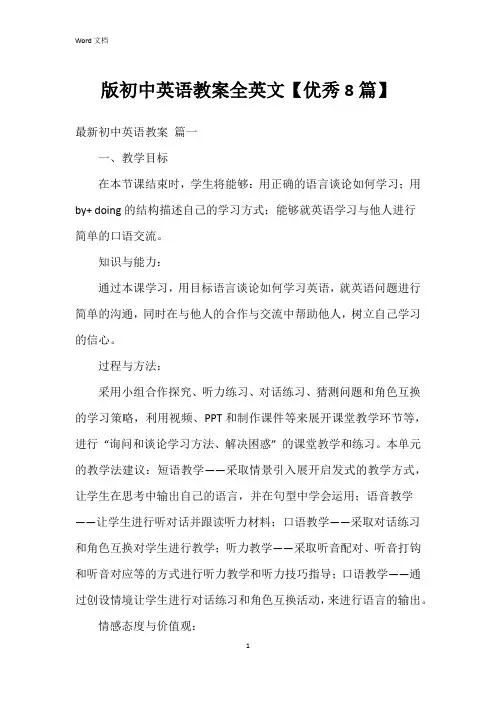
版初中英语教案全英文【优秀8篇】最新初中英语教案篇一一、教学目标在本节课结束时,学生将能够:用正确的语言谈论如何学习;用by+ doing的结构描述自己的学习方式;能够就英语学习与他人进行简单的口语交流。
知识与能力:通过本课学习,用目标语言谈论如何学习英语,就英语问题进行简单的沟通,同时在与他人的合作与交流中帮助他人,树立自己学习的信心。
过程与方法:采用小组合作探究、听力练习、对话练习、猜测问题和角色互换的学习策略,利用视频、PPT和制作课件等来展开课堂教学环节等,进行“询问和谈论学习方法、解决困惑” 的课堂教学和练习。
本单元的教学法建议:短语教学——采取情景引入展开启发式的教学方式,让学生在思考中输出自己的语言,并在句型中学会运用;语音教学——让学生进行听对话并跟读听力材料;口语教学——采取对话练习和角色互换对学生进行教学;听力教学——采取听音配对、听音打钩和听音对应等的方式进行听力教学和听力技巧指导;口语教学——通过创设情境让学生进行对话练习和角色互换活动,来进行语言的输出。
情感态度与价值观:通过参与课题教学活动,增进同学之间的了解和友情,并在交流中了解英语学习的方法,建立学习英语的自信。
二、教学重难点教学重点:学习并掌握How do you study...? I study...by ....等相关句型和词汇。
学习并掌握用by + doing 结构表达方式方法。
教学难点:学习并用丰富的语言描述英语学习的方式和方法。
三、教学策略短语教学——采取视频引入话题然后进行启发式教学,并在对话中运用;语音教学——让学生跟读听力材料进行模仿式操练;口语教学——采取pair work 和Role- play问答式的口语交际活动或小组活动互相操练;听力教学——采取采取听音配对、听音打钩和听音对应等方式语法教学——通过模仿听力材料进行对话练习,在教师的纠正中培养正确的by + doing 的结构意识。
初中英语公开课教案篇二课前准备教师:准备游戏时所用的图片(食物、蔬菜、动物)。
关于英语教案模板范文8篇
关于英语教案模板范文8篇英语教案模板范文篇1一、教学内容:1. 教学单词和词组:wave drive prridgewae up ae the bed I late.2.教学课文A部分:aties Da二、教学目标:1. 能听懂、会说、会写新单词和词组;2. 能感知,理解A 部分的语言材料;三、教学准备:单词卡片录音带四、教学步骤:Step 1 GreetingsStep 2 Waring up1.跟录音唱英语歌“Shell be cing rund the untain.”2.指名学生上台分别进行下列情境表演:起床,洗脸,吃饭,复习词组:gets up washes her face have breafast have lunc have dinnerStep 3 Practise1.教师要求学生先互相讨论自己的一天怎样度过,然后用简单的句子描述。
例如:I alwas get up earl ever da.I g t schl at seven clc.I g he at 4:50 p.I usuall watch TV at six lc.2.放课文录音,学生感知语言材料。
3.教学单词:wave drive prridge4.学生做拼读练习。
5.教学词组:wae up ae the bed I late.6.放课文录音,学生跟读课文。
Step 4 Cnslidatin学生自由读句子,熟悉课文。
Step 5 Hewr1.熟记本课单词和词组。
2.读熟课文。
英语教案模板范文篇2活动目标:学习单词bear(小熊) mountain(山) river(河流) 学唱儿歌The bear want over the mountain活动准备:单词卡片一个玩偶小熊活动过程:一、热身活动T: One, two, three.S: Be quite.T: Hello.S: Hello.T: Good morning, boys and girls.S: good morning, teacher.T: How are you?S: I’m fine. Thank you!T: Let’s sing, OK? the sing is“pussycat”二、学习新的儿歌1、出示小熊,并和孩子打招呼T: Hello, I’m bear.S: Hello, bear2、学习单词和儿歌,出示单词T: mountain, read after meS: mountainGame1把单词并排平铺在地上,边放边让幼儿读,请1个幼儿,人多了可以让幼儿分别站在单词两边,单词前放一组圈, 老师说:“Jump to …”(某个单词),幼儿可以“Jump to …”幼儿跳到单词后,可以问幼儿“What’s this?”。
初中英语教案的标准格式5篇
初中英语教案的标准格式范文5篇初中英语教案的标准格式范文1教学目标1.会使用可数名词和不可数名词开购物单。
为后两课学习购物做准备。
2. 学会讨论吃什么饭,买什么东西。
3.复习一些礼貌用语和习惯表达,如:How about…? What about…? Can you come with me? What do you have for dinner this evening? Let me and have a look.等。
4.新单词:chicken, tofu, fridge, list, shopping list, buy, kilo句型:What do we have for dinner this evening?Fish is my favourite.What else do you want to have?Don’t we have any eggs?Let me make a shopping list.You can help me carry the things.教学用具PPT教学演示课件教学步骤Step 1 Revision[课件展示]教师在课堂上提问题,引导学生回答What do you have for breakfast today? Shall we go and buy something to eat? What’s in the pictures? Let me see. What do we have for lunch today? How about…? What about…? What else do you want to have? Can you go and buy the things? Let’s go.等。
老师也可以同样的方式提问全班同学。
教师展示课件中Revision的食物图片,复习一些食品的名称。
Step 2 Presentation[课件展示]教师在复习食品名称基础上,引出购物的话题。
初中英语教案范本8篇
初中英语教案范本8篇各个教学步骤教学环节的时间安排等等,都要经过周密考虑,细心设计而确定下来,体现着很强的方案性。
下面是我给大家整理的学校英语教案范本,仅供参考盼望能够关心到大家。
学校英语教案范本篇1课时:1内容:SectionB(4)课型:写作课一.教材分析SectionB的第四部分为写作板块,主题围绕假期方案(vacationdreams)。
题目要求同学设想一个抱负中的假期并写下准备做什么,什么时候去,准备呆多久等信息。
这部分左边配有一幅插图,右边为示例范文的节选,给出了句型和语法。
教材要求同学完成一篇描写假期支配的小作文。
[分析缺乏条理性]二.学情分析本节课面对初二同学,年龄处于13,14岁之间,同学学习热忱高,自信念强。
经过初一的学习,同学已经具备较好的语言基础,有肯定的词汇量和语法学问,能够进行简洁的写作。
在上完本课SectionA的内容后,能正确拼写本课有关的词汇并把握了现在进行时表将来的时态。
面临的主要问题是部分同学一见到英语写作就产生恐慌心理,特殊是当看到有些情境难以用英语表达出来时。
再次,同学简单轻视谋篇。
认为书面表达构思简洁,只要没有语言、语法错误再加上几个”美丽”的句子就能拿高分。
其次,一些同学不知道写作的主旨意图,以为写作就是要完成老师布置的任务。
许多同学基本功很差,学习比较懒散,不愿积累。
三.教学目标分析1.语言学问目标2.语言技能目标能运用本课的词汇与句型写调查报告,介绍自己以及小组同学的度假支配;3.情感态度目标能在描述自己的方案和准备时,激起同学更加喜爱祖国的美妙河山。
4.学习策略目标:1.在学习中集中留意力;乐观思索;擅长记要点;2.学会科学支配自己的假期活动,能和合作伙伴相互沟通,充分交换信息。
3.能在小组活动中乐观与他人合作,相互关心,共同完成学习任务;4.在使用英语中,能意识到错误并进行适当的订正;5.文化意识目标了解英美国家的人们在工作之余是如何轻松度假的。
优秀初中英语教学教案5篇
优秀初中英语教学教案5篇优秀初中英语教案1一、教学目标1、复习一般疑问句is this a …? yes, it is.2、复习四个单词a banana , a pear , a mango和a peach。
3、能使用一般疑问句is this a …?向他人询问和确认某件物品,语音语调正确。
4、学习歌谣mango.二、教学重点、难点会说歌谣mango; 复习所学的内容,要求发音正确。
三、课前准备图片,录音磁带,单词卡片等,预先写好课题unit 5 fruit四、教学过程step 1sing a song组织学生齐唱歌曲goodmorning .step 2 free talk利用图片复习一般疑问句is this a …? yes, it is.及文具和水果单词。
t: hello, boys and girls. is this a …?ss: yes, it is.step 3 play a game这是一个“摸摸猜猜”游戏。
教师准备好一个不透明的包,放入需要的物品。
1、讲解游戏的做法。
2、带领全班学生做游戏。
教师先做示范。
t: boys and girls, let’s play a game.t: look! this is my bag. there are many fruit in it, but you can’t see it. you can touch and guess. let me try first.(教师将手伸入包里摸一下水果,想一下,然后闭上眼睛推测is this a ..?一边说一边将水果拿出来给学生看,等到学生给予应答后才睁开眼睛看自己说的对不对。
)优秀初中英语教案2一、教学目标:1. 语言知识目标:1) 能掌握以下单词:allow, wrong, guess, deal, work out能掌握以下句型:①—What’s wrong?—I’m really tried because I studied until midnight last night.② You could give him a ticket to a ball game.③ I think you should ask your parents for some money.④ Why don’t you talk to him about it?2) 能了解以下语法:(1)能够运用所学知识谈论问题和困难、提出建议并做出选择;(2)能根据对方所提出的问题,给出一些合理的建议。
- 1、下载文档前请自行甄别文档内容的完整性,平台不提供额外的编辑、内容补充、找答案等附加服务。
- 2、"仅部分预览"的文档,不可在线预览部分如存在完整性等问题,可反馈申请退款(可完整预览的文档不适用该条件!)。
- 3、如文档侵犯您的权益,请联系客服反馈,我们会尽快为您处理(人工客服工作时间:9:00-18:30)。
英语教案范文全英文版初中
【Analysis of the Teaching Material】
(I)STATUS AND FUNCTION
1.This unit is a revision unit, so it covers all communicative language knowledge learned from Unit 7 to Unit 11.
2.This lesson is the first one of Unit 12. So if the students can learn this lesson well, it will be helpful to make the students learn the rest of this unit.
3.This lesson is a dialogue about keeping fish. Such topic is related to daily life, so it is helpful to raise learning interests of students and it will be also helpful to improve their spoken English.
(II)TEACHING AIMS AND DEMANDS
Knowledge objects
1. To make the Ss know how to keep fish, birds or any other animal by learning the dialogue of this lesson.
2. To give a reinforced practice in the use of the Modal Verbs and some useful expressions for making suggestions.
Ability objects
3. To improve students’ listening and speaking ability by reading and practising the dialogue.
4. To develop students’ communicative ability by learning the useful expressions for making suggestions and replying. Moral objects
5. To enable the students to love life and animals, protect the nature and environment.
(III)TEACHING KEY POINTS:
1.To make the Ss grasp and understand the way of making suggestions and reply in daily life.
2.To enable the students to use useful expressions for making suggestion and replying in their own dialogues related to the daily life.
(IV)TEACHING DIFFICULTIES:
1. The usage of the Modal Verbs ,especially usage for making suggestions.
2. Using the learned phrases and sentence patterns to make suggestions and replying.
(V)TEACHING AIDS:
Multi-media computer; OHP(overhead projector); tape recorder; software: Powerpoint or Authorware
小学英语说课稿范文英文版PART 2
【Teaching Methods】
1>Five Steps Approach.
2>Communicative Approach.
小学英语说课稿范文英文版PART 3
【Studying Ways】
1. Teach the students how to be successful language learners.
2. Teach the students how to master dialogues and how to communicate with others.。
